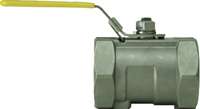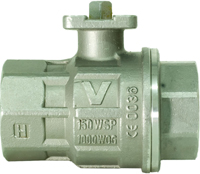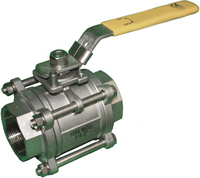One, Two and Three Piece Ball Valves Compared
You will notice our website categorizes our ball valves into 1, 2 and 3 piece designs ... which is best for your application?
This is why there are factory trained sales engineers waiting for you to contact them, because we can review your application requirements and offer a few alternatives to consider without having to delve into intricacies of designs.
 The
1 piece ball valve design tends to be the least expensive style having a
standard (reduced) port and a solid 1 piece cast
or molded body. Thus the
advantages are reduced leakage paths and initial cost. Disadvantages include
inability or difficulty with repairs (having to remove the entire valve from
the pipeline unless its a Hayward valve with true-union connections). Although we do offer
Fire Safe and
Control
Valve designs having a 1 piece body, there are more design and testing
standards associated with 2 piece and 3 piece valve designs. If you do
not have specific design, test and registration requirements, then selecting
a 1 piece design compatible with your flow rate, pressure and temperature is
the way to go.
The
1 piece ball valve design tends to be the least expensive style having a
standard (reduced) port and a solid 1 piece cast
or molded body. Thus the
advantages are reduced leakage paths and initial cost. Disadvantages include
inability or difficulty with repairs (having to remove the entire valve from
the pipeline unless its a Hayward valve with true-union connections). Although we do offer
Fire Safe and
Control
Valve designs having a 1 piece body, there are more design and testing
standards associated with 2 piece and 3 piece valve designs. If you do
not have specific design, test and registration requirements, then selecting
a 1 piece design compatible with your flow rate, pressure and temperature is
the way to go.
The complexity of 2 piece ball valves enables
satisfying many different industry design, testing and registration
standards which are a requirement for some applications. Examples
include
ball valves designed in compliance with NACE MR-0175,
ball valves tested in accordance with API 607 Fire Testing, and
CE Certification.
The two piece ball valve design only has 1 body joint, thus technically an additional leakage path when compared to a 1 piece design, although this joint can be welded. The 2 piece design has a larger variety of connection types and sizes compared to 1 piece designs and its likely the most common industrial ball valve design; especially for flanged connections.
 3 piece ball valves are the most complex because
they have the most parts,
which are necessary for the additional advantages this design offers, such
as the ability to repair the valve without disturbing the pipeline
connections. So you can imagine, for example, how important this feature is
if you have threaded or welded connections. With 3
piece ball valves we can also offer a variety of end connections,
for example the
MULTI-CHOICE series enables you to combine different inlet and outlet
connections, so the valve doubles as an adapter and potentially reducing the
number of fittings (leak paths) otherwise required; this is an advantage of
a 3 piece vs. 2 piece ball valve.
3 piece ball valves are the most complex because
they have the most parts,
which are necessary for the additional advantages this design offers, such
as the ability to repair the valve without disturbing the pipeline
connections. So you can imagine, for example, how important this feature is
if you have threaded or welded connections. With 3
piece ball valves we can also offer a variety of end connections,
for example the
MULTI-CHOICE series enables you to combine different inlet and outlet
connections, so the valve doubles as an adapter and potentially reducing the
number of fittings (leak paths) otherwise required; this is an advantage of
a 3 piece vs. 2 piece ball valve.
Special application valves, such those used for extreme temperatures (cryogenic applications), sanitary and piggable service all utilize the three piece design to ensure compatibility with the requirements of those special service conditions.
In summary, non-demanding light duty applications are good candidates for less expensive 1 piece ball valve designs whereas 2 and 3 piece ball valve designs are used for more demanding applications, whether that be extreme conditions or specialized design, test and certification criteria.




